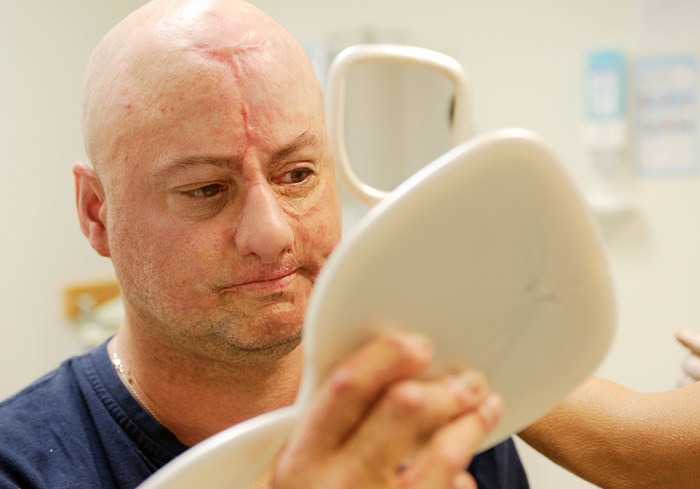Operation Mend uses reconstructive surgery to give injured soldiers back their lives

By Jennifer Chyu
Nov. 9, 2009 10:15 p.m.

The taste of dirt and gunpowder flooded his mouth and flames licked at his face before Staff Sergeant Mike Mills even felt the full force of the roadside explosive that forever altered his life.
A military man for 21 years, Mills, who was left without a nose and retired due to his medical condition, was resigned to live with the injuries he had sustained in Iraq in June of 2005, when his case manager at the Brooke Army Medical Center in Texas referred him to Operation Mend.
Operation Mend gave Mills his face back.
Sergeant Salvador Trujillo was doing a routine evening presence patrol in Iraq barely a year after Mills was injured when a roadside bomb exploded beneath his lightly armored Bradley fighting vehicle. Still in the burning vehicle, Trujillo radioed in to get help for himself and the six other men inside with him.
Trujillo, who enlisted at 18, was attracted to the military because college was his “last thought” and because he had seen images of courageous soldiers on TV. But because the bomb destroyed his neck and disfigured his eyes, nose and facial skin, he too was medically retired.
Operation Mend gave him his face back, too.
Established in 2007 by Ronald and Maddie Katz, Operation Mend seeks to connect U.S. military personnel who are victims of improvised explosive devices with the best plastic and reconstructive surgeons, according to its brochure. Operation Mend is a collaboration between UCLA and the Brooke center established through the donations of the Katz family, injured service members are first treated at a 42-unit burn center at BAMC before they are referred to UCLA.
Since its inception, Operation Mend has seen 32 patients and operated on 23 of them, some of whom required seven to eight operations to complete their facial reconstruction process, said Timothy Miller, chief of the Division of Plastic and Reconstructive Surgery at the UCLA David Geffen School of Medicine.
Miller is one of a handful of surgeons who works to mend the veterans’ injuries.
“To be a plastic surgeon is unique in this situation,” said Miller, who is a Vietnam War veteran. Miller has been with the project since its birth ““ from his first patient, who required 17 nose, lip and cheek operations. It has now become a “major entity to the university,” he said.
Mills joined the military in the footsteps of his 28-year veteran father and had only known a military life ““ he even met his wife while on duty in Alaska. He had several bad reactions to surgical anesthesia in prior operations and said he and his family were initially hesitant to have him undergo another procedure.
However, upon talking to doctors at Operation Mend, he felt comfortable being put under local anesthesia, and his three nose surgeries went smoothly. Mills has been retired and living in Minnesota since, traveling back and forth for his treatments.
Trujillo also traveled far for his operations. He had seen numerous surgeons about his facial reconstruction, but surgeons from the BAMC didn’t have anyone specializing in facial plastic surgery. Until he met Miller, facial reconstruction was just a fleeting vision. “I didn’t even have to speak. (Miller) already knew what I wanted,” Trujillo said. Two years and seven surgeries later, four to rebuild his neck and several operations on his eyes and nose, he’s now full of confidence living a close life with his family.
Expressing thanks for the Katz family, whose generous donations funded his flights and lodging, and to Miller, Trujillo said, “I was hoping for the best with nowhere to lean. Operation Mend was 100 pounds lifted off my shoulder.”


